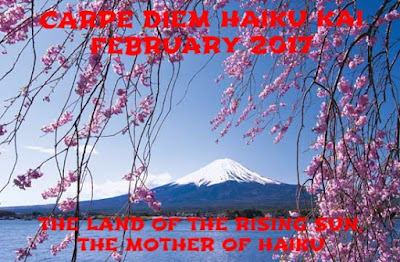Dear Haijin, visitors and travelers,
As I told you all earlier I have decided to create one episode of CDHK in every weekend, starting in March, because the lack of time gives me no other choice. I also will change a little in the appearance of CDHK. I am busy to create a new CDHK logo (as shown in the background) which I will use every month again, except in our anniversary month October. And I will cut back the special features, for example Universal Jane will be a bi-weekly feature. Our new feature Namasté will be a bi-weekly feature too, so these both special features will alternate. Than ... our CD Specials created after every kukai, will stay were they are and of course the Tokubetsudesu episode (for the "runner-up") will stay also.
Of course I will have the opportunity to treat you sometimes with one of our other special features here as for example "Imagination" and "Only the First Line".
Next to these changes I am busy with creating a Five Years of CDHK survey to hear from you. Your opinions, your thoughts and ideas and most of all how do you think about CDHK and do I need to change CDHK.
To give you already something to thing about "I am looking for a way to make it easier for myself, the first thing I thought of was "only an episode of CDHK on weekdays and no longer in the weekend". What do you think of that?
 |
| Bonsai the Japanese Art of Tree-scaping |
A bonsai is created beginning with a specimen of source material. This may be a cutting, seedling, or small tree of a species suitable for bonsai development. Bonsai can be created from nearly any perennial woody-stemmed tree or shrub species that produces true branches and can be cultivated to remain small through pot confinement with crown and root pruning. Some species are popular as bonsai material because they have characteristics, such as small leaves or needles, that make them appropriate for the compact visual scope of bonsai.
The source specimen is shaped to be relatively small and to meet the aesthetic standards of bonsai. When the candidate bonsai nears its planned final size it is planted in a display pot, usually one designed for bonsai display in one of a few accepted shapes and proportions. From that point forward, its growth is restricted by the pot environment. Throughout the year, the bonsai is shaped to limit growth, redistribute foliar vigor to areas requiring further development, and meet the artist's detailed design.
 |
| Bonsai (sumi-e painting) (found on Pinterest) |
Bonsai aesthetics are the aesthetic goals characterizing the Japanese tradition of growing an artistically shaped miniature tree in a container. Many Japanese cultural characteristics, in particular the influence of Zen Buddhism and the expression of Wabi-sabi, inform the bonsai tradition in Japan. A number of other cultures around the globe have adopted the Japanese aesthetic approach to bonsai, and, while some variations have begun to appear, most hew closely to the rules and design philosophies of the Japanese tradition.
Over centuries of practice, the Japanese bonsai aesthetic has encoded some important techniques and design guidelines. These design rules can rarely be broken without reducing the impact of the bonsai specimen. One of these techniques, principles is the following:
No trace of the artist: The designer's touch must not be apparent to the viewer. If a branch is removed in shaping the tree, the scar will be concealed. Likewise, wiring should be removed or at least concealed when the bonsai is shown, and must leave no permanent marks on the branch or bark.
In this principle we can find ourselves I think, because isn't that one of the rules or principles of haiku? I think it isn't a great sin to find the poet back in his/her haiku, but in a way it makes the haiku less strong, less beautiful, but ... at the other hand ... haiku is written right from the heart and than we, the poets, are visible or invisible, in our haiku.
"No trace of the artist", is what makes Bonsai and Haiku a strong pair ...
 |
| Pine Tree Bonsai |
anxious to see
the twin pine of the stories
once told
a tale on pine trees
bonsai like
bonsai like
the islands of Matsushima
covered with pines
but the wondrous twin pine
stays invisible
© Chèvrefeuille
Well I hope you did like this episode. You can submit your haiku, tanka or other Japanese poetry form right now until February 21st at noon (CET).

For my part, I think your idea of no weekend challenges and only 5 per week including the special features. You do need a life and good health, our friend and mentor.
ReplyDeleteThan you for understanding why I have to choose this solution. I am happy to hear that Janice.
DeleteI am always amazed at how dedicated you are to providing this place for us to learn and share. I respect the time you invest in each post, your love of Haiku shines through. You have cared for us and now you must care for yourself.
ReplyDelete